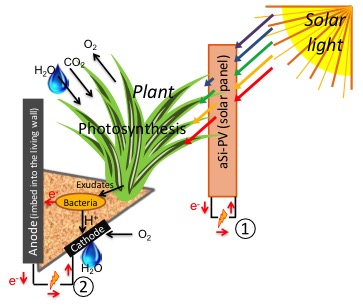The P2P aims to be an iconic architectural prototype that combines living wall, aSi-PV solar panels and plant-BES technologies in a single structure
1. The sun shines on the P2P hub.
2. The solar panels use some of the solar light (mainly UV, blue and green) for generating negative and positive charges. These charges are then recombined through an external circuit to create electrical current (see ① on diagram).
3. The living walls of plants photosynthesise, grow and release organic compounds into the soil.
4. These organic compounds feed bacteria living in the soil around the plant roots.
5. The bacteria in the soil oxidise the organic compounds, producing electrons which are collected by an anode, and protons which are collected by a cathode.
6. These electrons and protons are recombined and travel through an external circuit to produce electrical current (see ② on diagram).
7. The electrical current generated in ① and ② are monitored.
8. By integrating a-Si PV solar panels, living walls and plant-BES the P2P demonstrates how solar light can be used to generate electrical current by using and combining several different biological and non-biological technologies in a self-powering, sustainable system. It is demonstrated here as a bus shelter concept.

